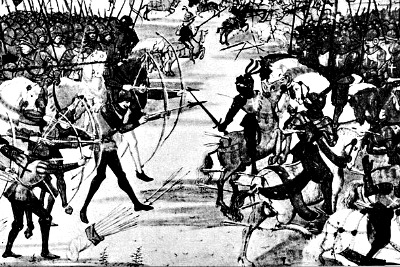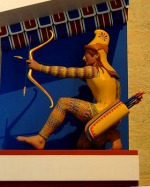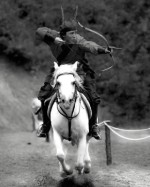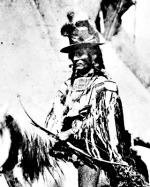Archery History in Medieval England
Talk the Talk
There were several types of medieval
crossbows used in Europe, such as the one and two-foot crossbows favoured in England.
The names of these denote whether the weapon took one foot or both to pull back the string with the latter being harder and slower to use, but more powerful.
The names of these denote whether the weapon took one foot or both to pull back the string with the latter being harder and slower to use, but more powerful.
Walk the Walk
An account from 1055 CE written by the Anglo-Saxon Earl of Hereford known as Ralph suggests that the Welsh were using longbows by at
least this time.
Ralph led an expedition into Wales and was ambushed in the mountains there where these ferocious medieval archers attacked with such accuracy and force that, according to the Abington Chronicle, the English fled without being able to mount a defence.
One contemporary estimate of the ambush suggests the English lost five hundred men whilst the Welsh suffered no losses at all.
Ralph led an expedition into Wales and was ambushed in the mountains there where these ferocious medieval archers attacked with such accuracy and force that, according to the Abington Chronicle, the English fled without being able to mount a defence.
One contemporary estimate of the ambush suggests the English lost five hundred men whilst the Welsh suffered no losses at all.
Archery Quote
"William de Braose also testifies that, in the war against the Welsh, one of his men-at-arms was struck by an arrow shot at him by a
Welshman.
It went right through his thigh, high up, where it was protected outside and inside the leg by his iron cuishes, and then through the skirt of his leather tunic; next it penetrated that part of the saddle which is called the alva or seat; and finally it lodged in his horse, driving in so deep that it killed the animal.
An arrow pinned the thigh of another soldier to his saddle, although the tassets of his leather tunic were there to protect him outside and inside the leg.
He tugged on the reins and pulled his horse round in a half-circle, whereupon another arrow, shot by the same bowman, hit him in exactly the same place in the other thigh so that he was skewered to his horse on both sides.
It is difficult to see what more you could do, even if you had a ballista".
~ Gerald of Wales (1188) ~
It went right through his thigh, high up, where it was protected outside and inside the leg by his iron cuishes, and then through the skirt of his leather tunic; next it penetrated that part of the saddle which is called the alva or seat; and finally it lodged in his horse, driving in so deep that it killed the animal.
An arrow pinned the thigh of another soldier to his saddle, although the tassets of his leather tunic were there to protect him outside and inside the leg.
He tugged on the reins and pulled his horse round in a half-circle, whereupon another arrow, shot by the same bowman, hit him in exactly the same place in the other thigh so that he was skewered to his horse on both sides.
It is difficult to see what more you could do, even if you had a ballista".
~ Gerald of Wales (1188) ~
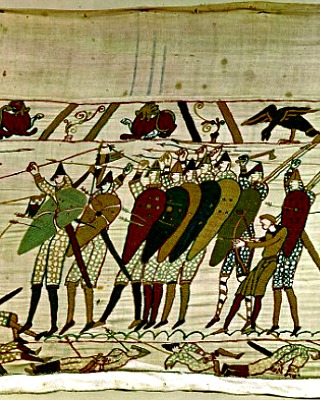 After the fall of the Roman Empire in the fifth century CE, the use of archery in warfare all but died out in Europe. This changed with the onset of the later middle ages when the medieval short bow began to be seen again on the battlefield.
After the fall of the Roman Empire in the fifth century CE, the use of archery in warfare all but died out in Europe. This changed with the onset of the later middle ages when the medieval short bow began to be seen again on the battlefield.The Medieval Short Bow
The short bows of the medieval period tended to be around three feet long and drawn from the chest and while useful against unarmed civilians and for hunting, as a weapon of war its application against the armour of the day was limited at best.Most armies did not employ archers early in the middle ages though there are a number of notable exceptions. King Harold (r. 1066) and his adversary William I (r. 1066 – 1087) of England are known to have used them early in the latter middle ages during the Battle of Hastings and they were used against the first Crusaders (1096–1099) by Turks on horseback but with little effect.
The Vikings used the medieval short bow extensively both on land and at sea. Even Viking rulers were often very skilled with the weapon, which was unusual in archery history as in other cultures such as the Normans and the Anglo-Saxons usually reserved them for low-born fighters. This can be seen from the section of the Bayeux Tapestry pictured above that shows an Anglo-Saxon archer alongside a group of infantrymen. Not only is the archer not wearing armour, but he is also depicted as being much shorter than his fellow countrymen which may be symbolic of his inferior social status.
The Medieval Crossbow
The crossbow is thought to originate from China in the third century CE and made its way to Europe before the fall of the Roman Empire, after which it seems to have fallen out of use. They reappear in the literature in France in the mid-tenth century and seem to have come into common usage in Europe from the late eleventh century. Previous versions of the weapon were usually large contraptions but the medieval crossbow began to appear as a lethal hand-held weapon.The Normans used crossbows to good effect after the Battle of Hastings against rebellious Anglo-Saxons who generally fought with medieval short bows. This gave the Normans a great advantage as it had a range of around 300 metres compared to only around a 200-meter shooting range with the short bow.
The crossbow of the middle ages did have a slower shot rate however, this was more than compensated by its greater power and by the fact that it was far more accurate.
The weapon was so fearsome that in 1139, papal officials in Rome decreed that it should only be used against infidels and those found using it against fellow Christians would be excommunicated. However this ruling was largely ignored and from the twelfth century, most major armies would employ large groups of crossbowmen, often on horseback, which gave them a distinct advantage over those who did not make use of the weapon.
The reputation of a crossbowman during the middle ages was a mixed bag as while they were seen as valued members of an army often commanding twice the wages of ordinary foot soldiers, when captured they would be treated as harshly as common criminals as opposed to valued prisoners of war as medieval knights would be, who would often be ransomed back to their king or lord.
The deadliness and accuracy of the crossbow not only had a profound effect on warfare, but it was also influential on architecture from the twelfth century. Because of its usefulness as a defensive weapon, slits were built into castle walls to allow for crossbowmen to fire out of and to curtail the effectiveness of enemy crossbowmen, shutters and breteches were added to the tops of the walls of castles and other fortifications.
The Medieval Longbow
The popularity of the crossbow in warfare would gradually give way in Europe to another form of medieval archery, the longbow. Generally, the medieval longbow was between 5ft 10” – 6ft (around 1.8 meters) in height and while the invention of this lethal weapon is often credited to the Welsh, it is actually known to have been around since at least the Roman period.Again, they probably fell out of use after the decline of the Roman Empire but were back in Europe by at least the eighth century, where bows of the appropriate length have been found in Lupfen, Germany and a century later in Ireland. Despite this, the Welsh were famous for their expert use of the medieval longbow and the weapon was predominantly used only by English and Welsh forces, with other nations only catching up in the latter half of the later medieval period by mimicking tactics used by the English longbowmen during the Hundred Years War (1337 to 1453).
It is commonly believed that the English adopted the use of the longbow under the reign of Edward I (r. 1272 – 1307) though there is little evidence
to support this. However, we do know that during the reign of his grandson, Edward III (r. 1327 – 1377), the weapon did gain prominence in the ranks of the English army.
Respect and Fear of the Medieval Longbowmen
It was during the Hundred Years War that medieval longbowmen seemed to gain a little respectability and many believe this happened as a direct result of events of the Battle of Poitiers in 1356 (depicted below). The English army, led by King Edward III’s son Edward, commonly known as the Black Prince, was heavily outnumbered with an estimated 7000 armoured horses, 3000 longbowmen and 100 light troops facing a combined French and German force that numbered anything from 20,000 to 50,000 troops.However, the longbowmen won the day and were so ferocious in their attack that at one point they ran out of arrows so had to advance to retrieve arrows protruding from their enemy’s bodies. The Black Prince had given a speech before the battle praising the archers for their bravery and skilfulness and it was not long after Poitiers that archers begin to appear as heroes in English literature, most notably in a poem from c.1377 called Piers Plowman which mentioned the outlaw Robyn Hode (Robin Hood).
Not only had the longbowmen become respected within medieval society, but they were also feared. This point is illustrated by the fact that after the Battle of Poitiers, the French started their own longbow unit which became so good that they were disbanded soon after for fear they may become too powerful.
This combination of respect and fear is also apparent in England as in 1363, it was decreed that all men were ordered to practice archery on Sundays and on holidays, a law that was to be enforced by local sheriffs. Despite this, in a bid to curtail the skill of any individual archer, it was also ordered that practice should take place at a given distance, a decree that would be reaffirmed both in 1512 and 1633.
By the end of the Hundred Years War, the Battle of Castillon fought in 1453 saw a turnaround in the fortunes of the medieval archers and their weapon of choice as the same tactics that had seen them dominate previously, now proved to be their undoing. They attacked the French artillery and were heavily defeated by the range capabilities of the cannons and muskets of their enemies. This is often cited in archery history as the beginning of the end of the dominance of weapons like the short bow, crossbow and longbow, and the beginning of the age of gunpowder and the firearm that would dominate the battlefields of the modern era.
Not only had the longbowmen become respected within medieval society, but they were also feared. This point is illustrated by the fact that after the Battle of Poitiers, the French started their own longbow unit which became so good that they were disbanded soon after for fear they may become too powerful.
This combination of respect and fear is also apparent in England as in 1363, it was decreed that all men were ordered to practice archery on Sundays and on holidays, a law that was to be enforced by local sheriffs. Despite this, in a bid to curtail the skill of any individual archer, it was also ordered that practice should take place at a given distance, a decree that would be reaffirmed both in 1512 and 1633.
By the end of the Hundred Years War, the Battle of Castillon fought in 1453 saw a turnaround in the fortunes of the medieval archers and their weapon of choice as the same tactics that had seen them dominate previously, now proved to be their undoing. They attacked the French artillery and were heavily defeated by the range capabilities of the cannons and muskets of their enemies. This is often cited in archery history as the beginning of the end of the dominance of weapons like the short bow, crossbow and longbow, and the beginning of the age of gunpowder and the firearm that would dominate the battlefields of the modern era.
Written by Andrew Griffiths – Last updated 06/06/2023. If you like
what you see, consider following the History of Fighting on social media.
Find Us On:



Further Reading:
Alchin, L. [Internet]. 2014. Medieval Archer. Medieval Life and Times. Available from: http://www.medieval-life-and-times.info/medieval-life/medieval-archer.htm [Accessed August 18, 2014].English Monarchs 400 AD-1603. [Internet]. 2009. The British Monarchy. Available from: https://www.royal.uk/william-the-conqueror [Accessed August 18, 2014].
Gerald of Wales. 2004. The Journey Through Wales and the Description of Wales. Penguin Classics. London.
Lienhard, J. H. [Internet]. 1997. The Crossbow. The University of Houston. Available from: http://www.uh.edu/engines/epi625.htm [Accessed August 18, 2014].
Madlala, D. Et al. [Internet]. 2014. Bayeux Tapestry Project. Amherst College. Available from: https://blogs.ats.amherst.edu/hist-120-1314s-bayeux-tapestry/projects/panels-129-155 [Accessed August 18, 2014].
The History of Archery. [Internet]. 2005. The University of Southampton. Available from: http://www.southampton.ac.uk/~archclub/bowhistory.php [Accessed August 18, 2014].
More Archery History
Archery History Home
The bow and arrow has been used since at least the Palaeolithic Era (late Stone Age) and the earliest known composite bow was used in Egypt c.2800 BCE. Ancient and medieval archery were used for hunting and warfare though with the invention of the firearm, modern archery has developed into a popular sport that is enjoyed all over the world.
The bow and arrow has been used since at least the Palaeolithic Era (late Stone Age) and the earliest known composite bow was used in Egypt c.2800 BCE. Ancient and medieval archery were used for hunting and warfare though with the invention of the firearm, modern archery has developed into a popular sport that is enjoyed all over the world.
Mongolian Archery
The history of Mongolian archery dates back for thousands of years and has been used for hunting, sport and warfare. The Mongolian bow was one of the most powerful hand-held weapons in the world up to the modern era and helped Genghis Khan and his descendants build one of the largest empires the world has ever seen.
The history of Mongolian archery dates back for thousands of years and has been used for hunting, sport and warfare. The Mongolian bow was one of the most powerful hand-held weapons in the world up to the modern era and helped Genghis Khan and his descendants build one of the largest empires the world has ever seen.
The History of Archery in Korea
The history of archery in Korea stretches back to pre-history and the bow and arrow has been used there since at least the fifth century BCE. Traditional Korean archers helped to unify the country, gain independence from China and later to fend off Japanese invaders. In modern times, South Korea are
continuously making Olympic archery history and are widely considered to be the best in the world.
Making the Native American Bow and Arrow
The making of the Native American bow and arrow was a complex, time consuming process. Various different materials were used depending on what was available to the craftsman, but each weapon had to be made to a high standard as it would provide a Native American warrior and his tribe food when used for hunting and protection when used in battle.
The making of the Native American bow and arrow was a complex, time consuming process. Various different materials were used depending on what was available to the craftsman, but each weapon had to be made to a high standard as it would provide a Native American warrior and his tribe food when used for hunting and protection when used in battle.
The images on this site are believed to be in the public domain, however, if any mistakes have been made and your copyright or intellectual rights have been breeched, please contact andrew@articlesonhistory.com.

